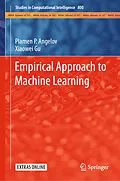This book provides a 'one-stop source' for all readers who are interested in a new, empirical approach to machine learning that, unlike traditional methods, successfully addresses the demands of today's data-driven world. After an introduction to the fundamentals, the book discusses in depth anomaly detection, data partitioning and clustering, as well as classification and predictors. It describes classifiers of zero and first order, and the new, highly efficient and transparent deep rule-based classifiers, particularly highlighting their applications to image processing. Local optimality and stability conditions for the methods presented are formally derived and stated, while the software is also provided as supplemental, open-source material. The book will greatly benefit postgraduate students, researchers and practitioners dealing with advanced data processing, applied mathematicians, software developers of agent-oriented systems, and developers of embedded and real-time systems. Itcan also be used as a textbook for postgraduate coursework; for this purpose, a standalone set of lecture notes and corresponding lab session notes are available on the same website as the code.
Inhalt
Introduction.- Part I: Theoretical Background.- Brief Introduction to Statistical Machine Learning.- Brief Introduction to Computational Intelligence.- Part II: Theoretical Fundamentals of the Proposed Approach.- Empirical Approach - Introduction.- Empirical Fuzzy Sets and Systems.- Anomaly Detection - Empirical Approach.- Data Partitioning - Empirical Approach.- Autonomous Learning Multi-Model Systems.- Transparent Deep Rule-Based Classifiers.- Part III: Applications of the Proposed Approach.- Applications of Autonomous Anomaly Detection.
